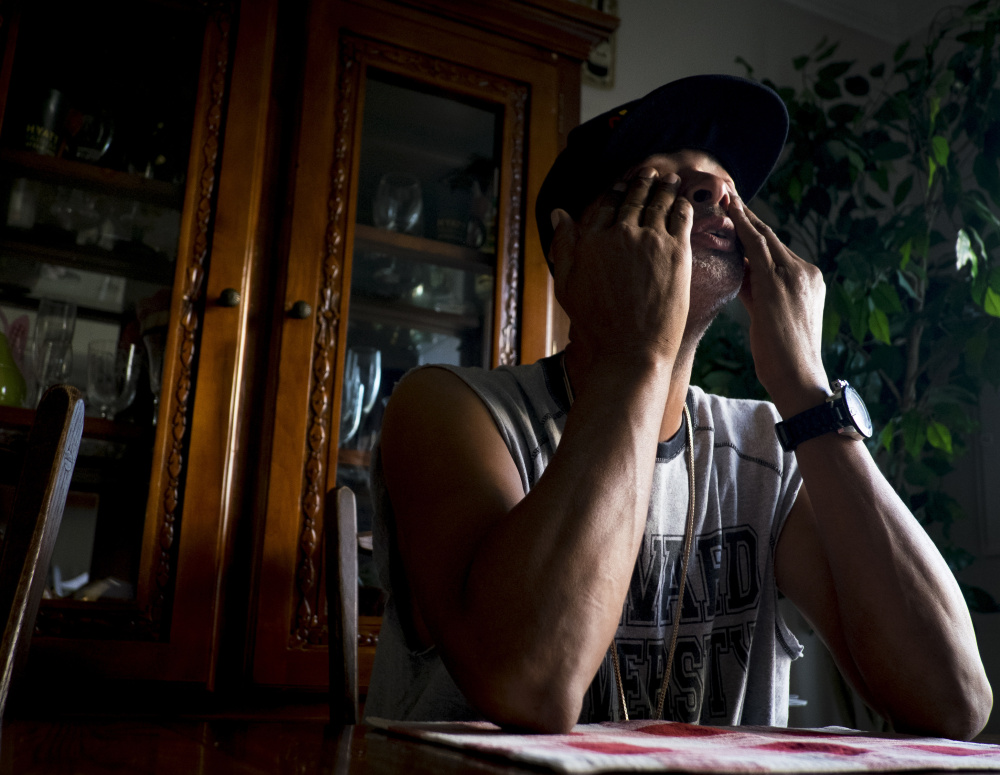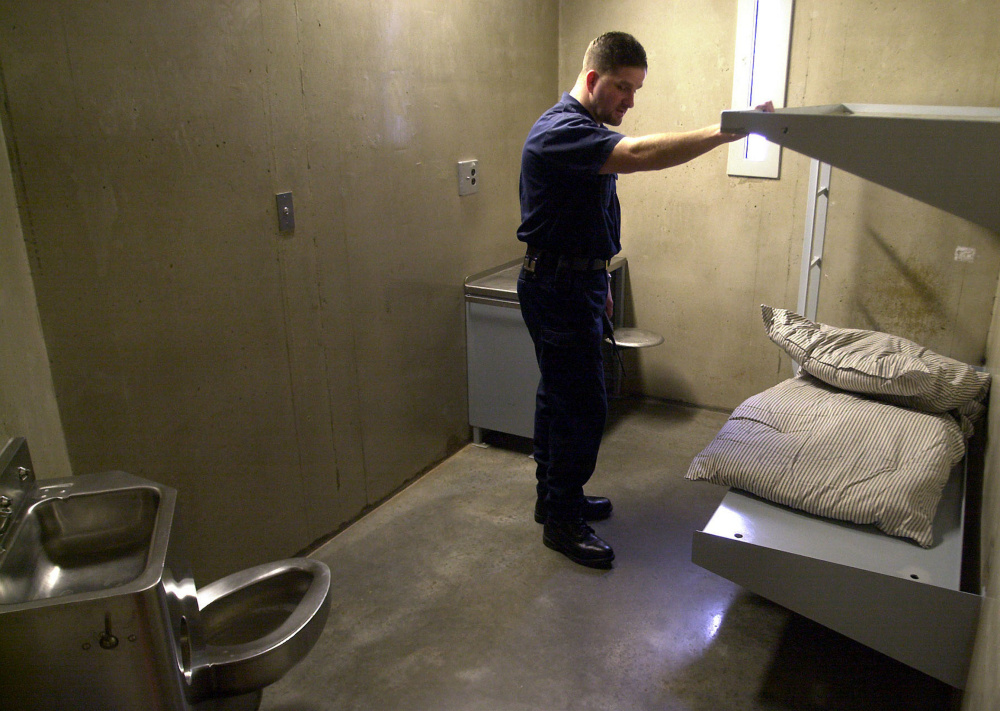He can’t forget the first day. White walls. Room the size of a ping-pong table. The silence.
It came in November 2014. Kevin Bushrod Jr. said he didn’t understand why he was isolated. A cop had pulled him over for driving on a suspended license. He tried to escape. The cop shot him in the left shoulder. Bushrod, a former top athlete at a Bible college, was charged with assault on an officer while armed – the car was the weapon. And now, he was here. Facing years in prison. Alone in a cell with little beyond a steel toilet and sink.
Bushrod, whose medical records show that he suffers from post-traumatic stress disorder, depression and anxiety, said he waited until evening so he could be sure that guards wouldn’t check on him. He said he wept, pulling the sheet off his bed. He said he folded it into a noose. He said he tied one end to the top of a bunk bed and lowered himself.
And, he said, when he realized he couldn’t even successfully kill himself, he felt a sense of failure so profound he could barely catch his breath. This was Bushrod’s first day in the District of Columbia’s Special Management Unit. Six months he would spend in isolation in the darkest corner of the city’s jail system, wondering why he was there and when, if ever, he would get out.
REFORMING THE HOLE
The use of solitary confinement has reached a watershed moment. Most experts agree that the hardships placed upon thousands of isolated prisoners, some of whom are mentally ill, push them to a dangerous place. President Obama announced a ban last week on isolating juveniles in federal prisons and reduced the maximum number of days federal inmates can be isolated for a first offense from 365 days to 60.
The reforms, however, will do nothing to change the circumstances of the vast majority of the nation’s isolated inmates. Roughly 90 percent of these prisoners, like Bushrod, are held at state and county facilities – each with its own definitions of confinement. Some states – New York, Colorado and California – have promised to reduce the number of inmates in solitary confinement and how long they can stay there.
But isolation has been a pillar of American justice since the 1800s and remains one of the first methods institutions use to punish and protect inmates.
“It is a needed tool within correctional management,” said Thomas N. Faust, director of the D.C. Department of Corrections. “However, I think that we need to do a better job of it.”
A national survey released in September, conducted by Yale Law School and the Association of State Correctional Administrators, suggested that between 80,000 and 100,000 inmates are in isolated confinement – roughly the same estimate as a decade ago.
“It’s really hard to turn the Titanic,” said Deborah Golden, director of the D.C. Prisoners’ Project of the Washington Lawyers’ Committee. Reform at the state level “can’t be created overnight.”
Another problem, underscored by Obama’s call for greater transparency, is institutional opacity. Some facilities don’t keep records or disclose how often they isolate inmates.
A HIDDEN WORLD
The most inscrutable pocket, experts agree, is administrative segregation. Unlike disciplinary detention, which often has clear procedural guidelines and time limits, this isolation unit has fewer encumbrances. In the District, jail officials reserve it for prisoners considered an escape risk or a danger to others or to the institution, and they wield wide discretion in deciding who fits that bill. Inmates don’t receive legal representation to contest that reasoning.
And, in late 2014, this was where Bushrod found himself.
A product of what court records call an alcoholic mom and an absent father, the 29-year-old grew up in Northeast Washington and later picked up convictions for possession of cocaine, attempting to carry a pistol without a permit and attempted robbery.
But Bushrod thought he had turned his life around. Between 2010 and 2012, he attended Washington Bible College, pulling in good grades. He got on the basketball team. He preached at the City of Zion Church in Laurel, Maryland, “becoming a role-model for young men in and outside of the church,” one psychologist added in a court letter.
And now, here he was again, inside a cell – but this one was different. Bushrod had only five hours per week outside its confines, and he felt demons tugging at his thoughts. The police officer’s gunshot had “shattered” his left humerus, medical records show, and would “likely exacerbate” his PTSD.
Bushrod had just tumbled into administrative segregation, where inmates have spent years.
The agency’s program manual says a panel of three employees called the Housing Board holds hearings with inmates, explains why they warrant segregation and affords them an opportunity to dispute that rationale.
But the jail doesn’t record the frequency of these meetings, how often inmates appeal its decisions or the number of prisoners found to be a risk.
Bushrod said the process was simple. Every few weeks, he said, one female employee would come by his cell. “She used to give me a form to sign every month saying that they had a board hearing and this was the decision they made,” he said. “I would just sign it and get her out of my face. There were no hearings.”
A ROUGH ADJUSTMENT
The patient “presents with extremely depressed mood, withdrawn affect, negative outlook,” the medical examiner wrote in November. Bushrod, following two months in isolation under medical supervision, was trying to adjust to the Special Management Unit. The psychiatric medication, he told clinicians, wasn’t helping his depression.
He “expressed frustration with legal situation as he feels he is wrongly accused of charges he faces,” the report said. He “reports limited family support and a sense of isolation since his on lock 23 hours per day because of his custody level.”
Despite how distraught Bushrod appeared throughout these weeks – “freaking out,” he told doctors – he denied harboring suicidal thoughts, and it’s unclear whether the medical staff knew about his suicide attempt. Bushrod had heard rumors that suicidal inmates are stripped naked and placed in even more austere conditions.
Suicide, self harm and segregation have long had a close relationship at the District jail. Nearly 60 percent of the jail’s 49 suicide attempts in 2013 occurred in a segregation unit. The Department of Corrections recommended: “Consistent with national recommendations on suicide prevention, NO ONE is placed in a single cell unless there’s an overwhelmingly compelling reason to do so.”
Bushrod pleaded for answers in a grievance report. “At this juncture, I am almost at a loss for words,” Bushrod wrote. “… I have suffered unjustly and been given insufficient excuses as to why.”
But, days later, he thought everything was about to change. His trial had arrived. And the most serious allegation – that he had assaulted a police officer while armed with a car – suddenly looked shaky.
The officer, Zachary Blier, said he’d tried to pull Bushrod over in September 2014 for driving on a suspended licence. Bushrod tried to escape, court records say, running a red light before slowing to a stop. Blier then approached Bushrod, gun drawn, and opened the car door. The officer grabbed Bushrod, who put it in reverse. The car jerked backward, and the open door hit Blier’s leg. Blier said he feared for his life and shot Bushrod.
The jury acquitted Bushrod of the allegation he assaulted Blier with a deadly weapon. But it convicted him of misdemeanor assault on a police officer. Having shaken off a charge that could have locked him up for years – and guilty of lesser allegations – Bushrod thought his time in solitary confinement was over.
STRESS REMAINS
In March, over two months later, a medical report filed said: He “continues to stress about his legal situation and being on segregation unit.”
Jail officials now say they’re working on making it easier for inmates with mental illness to return to the general population. Described as an “intermediate unit,” Faust described it as “pathway for them to step down from segregation.”
But that sudden juxtaposition between life inside the hole and life outside was one of the hardest parts of isolation, Bushrod said. In May 2015, he emerged from what he called “a whole other world” and now struggles in social situations in federal prison in Cumberland, Maryland, where he’s serving an 18-month sentence. He looks older than his 29 years. His shoulder never healed properly, he said.
So he tries to focus on the future. Awaiting release, he talks to his old girlfriend about getting back together. He talks about getting back into school. Starting a business. Maybe picking up ministry responsibilities. He talks about anything, except for what he’s been through. Solitary confinement marked the lowest months of his life. And no way, he says, is he going back.
Copy the Story LinkSend questions/comments to the editors.




Success. Please wait for the page to reload. If the page does not reload within 5 seconds, please refresh the page.
Enter your email and password to access comments.
Hi, to comment on stories you must . This profile is in addition to your subscription and website login.
Already have a commenting profile? .
Invalid username/password.
Please check your email to confirm and complete your registration.
Only subscribers are eligible to post comments. Please subscribe or login first for digital access. Here’s why.
Use the form below to reset your password. When you've submitted your account email, we will send an email with a reset code.